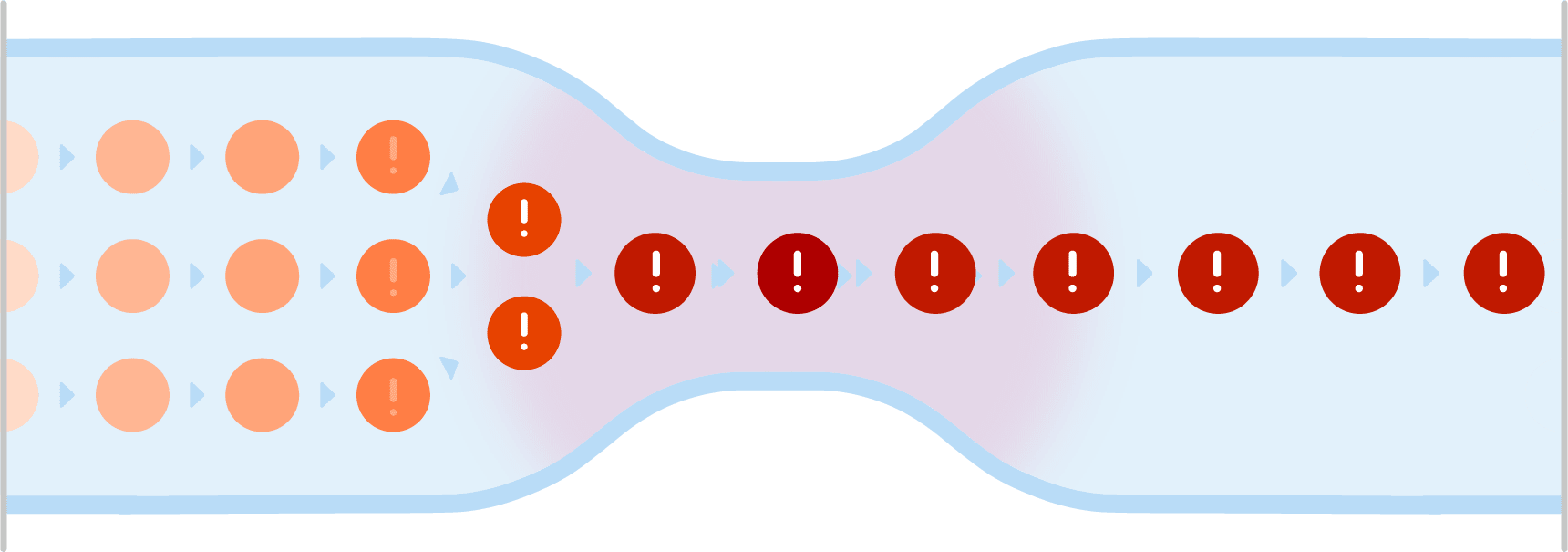Identifying and preventing bottlenecks: A guide for modern businesses
Master the art of spotting and resolving bottlenecks with intelligent automation, ensuring smoother processes and enhanced productivity in your business.
Master the art of spotting and resolving bottlenecks with intelligent automation, ensuring smoother processes and enhanced productivity in your business.

Bottlenecks can significantly impede business operations, leading to increased costs, delays in project timelines and strained customer relationships. These operational hurdles often result in inefficiencies that compromise overall productivity and profitability.
Identifying and preventing bottlenecks is crucial for maintaining smooth workflows, meeting customer expectations and achieving business success. By proactively addressing these constraints, organizations can streamline processes, optimize resource allocation and foster a more agile and responsive business environment.

Bottlenecks are congestion points in a workflow where the demand for resources exceeds the capacity, causing delays or halts in production. These blockers create backlogs that negatively affect productivity by slowing down the entire process, leading to increased operational costs.
Additionally, bottlenecks can strain customer relationships due to delayed deliveries and unmet expectations, ultimately impacting the business's reputation and bottom line.
There are two primary types of bottlenecks in business — long-term and short-term. Let's explore the difference between the two below.
Short-term bottlenecks
Short-term bottlenecks are temporary disruptions in workflow caused by unforeseen issues or relatively minor inconveniences. This can create immediate, albeit brief, interruptions that hinder productivity and efficiency. Examples of short-term bottlenecks include:
Long-term bottlenecks
Persistent inefficiencies in business processes that consistently hinder workflow and productivity are termed as long-term bottlenecks. These bottlenecks often stem from systemic issues that require strategic intervention to resolve, such as:

Explore Gartner’s analysis of 15 vendors in the document management space, and see why Hyland was named a Challenger with strengths in our scalability, open source and industry-specific capabilities.
Identifying bottlenecks is crucial for preventing delays and optimizing workflows, enabling businesses to address inefficiencies at their root. This leads to smoother operations, reduced costs, and improved productivity and customer satisfaction.
Let’s explore three primary methods for identifying bottlenecks:
Mapping out each step of a process in a flowchart helps visualize bottlenecks by providing a clear overview of the workflow, highlighting where delays and inefficiencies occur. By breaking down the process into individual steps, it becomes easier to pinpoint stages that require improvement.
For example, in the development phase of a marketing campaign, a flowchart might reveal that the approval process is causing significant delays. By visualizing this bottleneck, the team can identify that streamlining approvals or increasing communication between departments could improve efficiency.
The 5 Whys technique is a problem-solving method used to identify the root cause of an issue by asking "why" repeatedly. Each answer forms the basis of the next question, and this iterative process helps peel away layers of symptoms. As an example, if there are delays in a marketing campaign, you may ask yourself these questions to reveal the underlying cause of your problem:
By the end of the fifth "why," you would have identified the root cause (lack of access to historical data and feedback), which allows for more effective problem-solving and preventive measures going forward.
Tracking metrics such as wait times, backlog volume and throughput is crucial for identifying bottlenecks in business processes. For instance, longer wait times or a significant increase in backlog volume can indicate a bottleneck in the workflow.
When you monitor these metrics closely, you can see which specific areas are causing inefficiency in the overall process. From there, you can use those insights to address the root cause of the problem and enhance productivity.

Once bottlenecks are identified, it's essential to address them promptly to prevent further delays, improve productivity and enhance overall efficiency. In the following sections, we'll highlight three strategies for addressing bottlenecks effectively to streamline workflows and optimize business processes.
To increase efficiency in bottleneck stages, businesses can implement several strategies:
Decreasing input can also reduce bottlenecks, as there are fewer projects and tasks for teams to tackle. Here are some ways to do so:
Open communication between departments is crucial in preventing misunderstandings and streamlining processes, thereby reducing the risk of bottlenecks. These surefire methods are guaranteed to improve communication gaps:
Intelligent automation plays a crucial role in identifying and preventing bottlenecks by leveraging technologies like robotic process automation (RPA) and intelligent document processing (IDP). RPA can automate repetitive tasks, which reduces human errors and speeds up processes. IDP uses AI to extract valuable content and insights from documents, which enhances decision-making and optimizes workflows.
These technologies offer businesses benefits such as increased efficiency, reduced operational costs, improved accuracy and enhanced scalability, making them valuable assets in bottleneck detection and resolution strategies.
Hyland RPA is a comprehensive robotic process automation solution designed to streamline and optimize repetitive tasks across business processes.
Analyze tasks, processes and workflows
By capturing and sequencing process steps, Hyland RPA can help document workflows, enabling humans to analyze them and identify inefficiencies or bottlenecks. This documentation allows for targeted optimization before automation, enhancing overall process performance.
Additionally, having an enterprise advising team with deep industry expertise can add value by evaluating the documented process, identifying bottlenecks and designing a tailored solution to optimize workflow efficiency and effectiveness.
Design and build new automations
The low-code drag-and-drop tools in Hyland RPA accelerate the creation of new automations, significantly reducing bottlenecks and streamlining development processes.
Its seamless integration with core systems allows for easy incorporation of automation process parameters and output process scripts, ensuring efficient bot execution and optimized workflow management.
Run automated processes enterprise-wide
Efficiency is enhanced by reallocating idle bots through unique task "pulling" mechanisms and leveraging a farm of multifunctional bots to process any task type effectively. This dynamic approach ensures balanced and efficient workflows, complementing human efforts.
Manage automations from one central interface
A centralized interface offers numerous benefits for managing and customizing automations, providing a comprehensive view for management with real-time monitoring, precise control and detailed reporting. Moreover, its intuitive modification controls empower users to adapt and optimize processes.

Hear from industry experts from Hyland and Deep Analysis as they cover key findings from the recent Deep Analysis: Market Momentum Index report. Learn the current trends, actionable strategies and best practices to overcome challenges like data quality and process optimization.
Hyland IDP serves as a vital tool in eliminating bottlenecks related to manual document processing, a common factor that can substantially impede business cycle times.
Automate document capture and classification
Harnessing the power of AI, Hyland IDP continuously learns, adapts and enhances document processing. This capability reduces time and cost investments, minimizes exceptions and effectively mitigates bottlenecks in document-related workflows.
> Learn more | What can you do with Hyland IDP?
Enable intelligent data extraction and validation
Employing a sophisticated deep-learning optical character recognition (OCR) engine, Hyland IDP precisely extracts data from documents. This advanced technology significantly reduces the risk of errors and accelerates the speed of document processing, ensuring efficient and accurate data extraction.
Scale with your business needs
With exceptional scalability and flexibility, Hyland IDP is perfectly suited for managing vast volumes of documents. Its integration capabilities span a range of enterprise applications and ensure smooth workflow transitions, as well as enhanced productivity in diverse business settings.
Identifying and preventing bottlenecks is crucial for business success — it directly impacts productivity, customer satisfaction and cost-efficiency. By leveraging intelligent automation solutions like Hyland RPA and Hyland IDP, businesses can optimize workflows, proactively prevent delays and maintain peak operational efficiency.
These technologies not only streamline processes but also empower organizations to adapt quickly, stay competitive and deliver exceptional results in today's fast-paced business environment.

An in-depth look into on-prem and cloud solutions for enterprise IT infrastructure, and practical considerations for content management.

The use of AI in process automation will disrupt workplaces — just make sure your organization is leading.

Learn how ECM is evolving to meet the changing needs of today's organizations, and explore key trends and features in modern ECM solutions.

Discover the tools and techniques of bottleneck analysis to unlock your organization’s full potential and achieve sustainable growth.